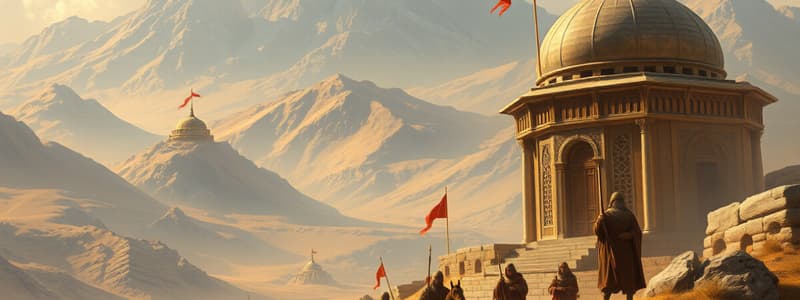Podcast
Questions and Answers
Where were the Seljuks located?
Where were the Seljuks located?
Central Asia, established base in Iran and Afghanistan
What was the capital of the Seljuks?
What was the capital of the Seljuks?
Isfahan
What is the language of culture for the Seljuks?
What is the language of culture for the Seljuks?
Persian
Who was the Sultan that expanded power into Syria and drove out the Fatimids?
Who was the Sultan that expanded power into Syria and drove out the Fatimids?
Who ruled after the Seljuks became weaker and brought the Abbasid caliph to Egypt?
Who ruled after the Seljuks became weaker and brought the Abbasid caliph to Egypt?
Who were Saladin's major rivals?
Who were Saladin's major rivals?
What are Mamelukes?
What are Mamelukes?
What does Ghazi refer to?
What does Ghazi refer to?
What is a Janissary?
What is a Janissary?
What does Devshirme refer to?
What does Devshirme refer to?
What does Millet mean?
What does Millet mean?
What are the four social classes with appointed rule?
What are the four social classes with appointed rule?
What defines the Safavid Empire?
What defines the Safavid Empire?
Who was Isma'il?
Who was Isma'il?
What is Shah Abbas known for?
What is Shah Abbas known for?
Who was Osman?
Who was Osman?
What did Murad II accomplish?
What did Murad II accomplish?
What is Mehmet II known for?
What is Mehmet II known for?
What does Selim the Grim refer to?
What does Selim the Grim refer to?
Who is Suleiman known as?
Who is Suleiman known as?
What defines the Ottomans?
What defines the Ottomans?
Who were the Mughals?
Who were the Mughals?
Who was Babur?
Who was Babur?
What is Akbar the Great known for?
What is Akbar the Great known for?
Who was Jahangir?
Who was Jahangir?
Who was Nur Jahan?
Who was Nur Jahan?
What did Aurangzeb do?
What did Aurangzeb do?
What is Shah Jahan known for?
What is Shah Jahan known for?
Flashcards are hidden until you start studying
Study Notes
Seljuks
- Originated in Central Asia, with an established base in Iran and Afghanistan.
- Capital city was Isfahan.
- Persian served as the language of culture.
Malik Shah
- Prominent Sultan who emerged after civil wars against family members.
- Led efforts to drive Byzantines from most of Anatolia after winning the Battle of Manzikert.
- Expanded influence into Syria, displacing the Fatimids.
Saladin
- Ruled following the decline of the Seljuks and brought Abbasid caliphate to Egypt.
- Major rivals included Sinan, leader of the Assassins, and Christian crusaders.
Military Structure
- Mamelukes, a class of Turkish military slaves.
- Ghazi, Islamic warriors formed military societies.
- Janissaries were elite soldiers in the Ottoman Empire.
- Devshirme was the policy of recruiting Christian children to be trained as Muslim soldiers.
Social Structure
- Four appointed social classes:
- Men of the Pen
- Men of the Sword
- Men of Negotiation
- Men of Husbandry
Safavid Empire
- Membership based on an Islamic religious brotherhood; prominent leader was Abbas the Great.
- Predominantly Shiite Muslims with a powerful military influenced by Ottoman janissaries.
- Centralized government structure.
Key Leaders
- Isma'il: Also known as leader of the redheads, conquered modern-day Iran and claimed the title of Shah.
- Shah Abbas: Known as "The Great," established a centralized government in the Safavid Empire.
- Osman: Founder of the Ottoman state, successful as a Ghazi in Anatolia.
- Murad II: Restored Ottoman military power and defeated the Venetians.
Notable Ottoman Conquests
- Mehmed II conquered Constantinople in 1453, transforming the Hagia Sophia into a mosque.
- Selim the Grim overthrew his father and defeated Safavid forces, earning the nickname "Yafuz" meaning "the inflexible."
- Suleiman the Magnificent, known for his wealth and legal reforms, provided support to the Janissaries.
Mughal Empire
- Mughals were invaders from Central Asia who entered India.
- Babur, at age 11, inherited a kingdom from Genghis Khan and Tamerlane.
- Akbar the Great, Babur's grandson, was noted for religious toleration and governmental centralization.
- Jahangir, his son, was an ineffective ruler, causing conflict with Sikhs.
- Nur Jahan, Jahangir's wife, was a Persian princess who opposed religious tolerance.
- Aurangzeb, son of Shah Jahan, was known for oppressive governance and resource depletion.
- Shah Jahan, also known as Prince Khurram, is remembered for constructing the Taj Mahal, referred to as "Dream in Marble."
Studying That Suits You
Use AI to generate personalized quizzes and flashcards to suit your learning preferences.




